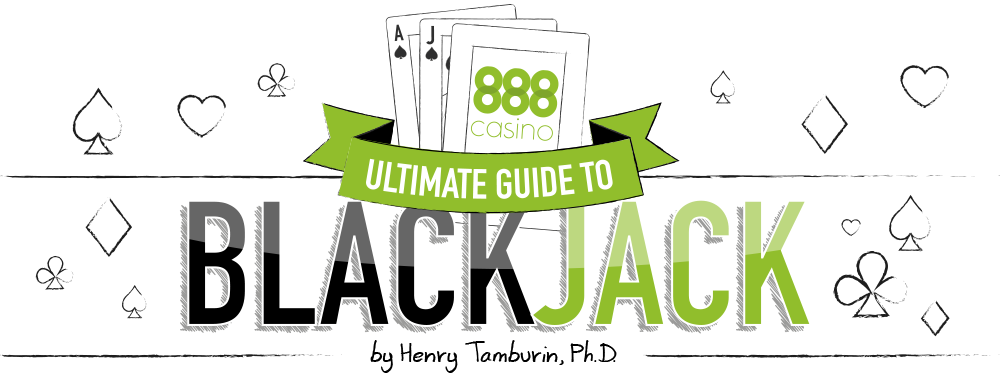
BLACKJACK SIDE BETS

In an effort to encourage more players to play blackjack, and also to improve their margins, many land-based and online casinos have added side bets on their blackjack tables. The innocent-looking side bets usually require a rather small wager (typically only a dollar), and they generally have payoffs that are greater than the customary even-money blackjack payoffs. In this Chapter, I’ll explain some of these side bets and answer the question, “Are they worth a wager?”
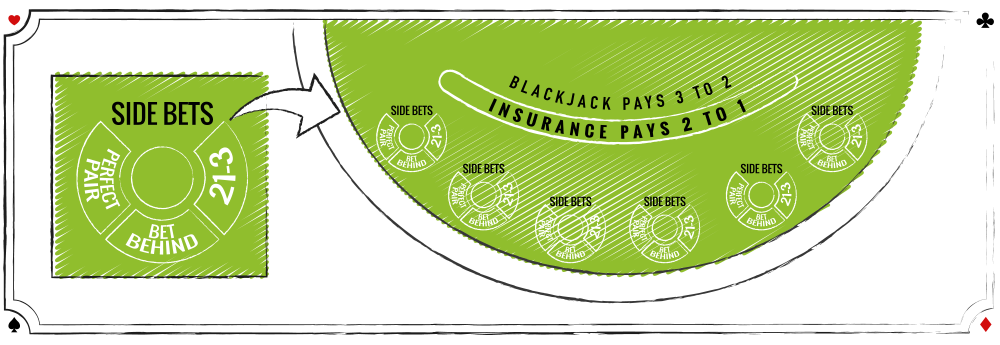
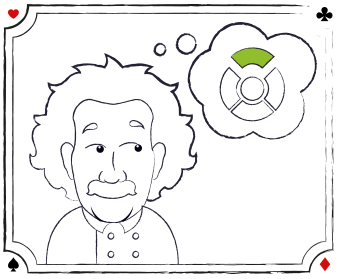
WHY OFFER SIDE BETS?
It’s no secret that blackjack has a low house edge (around half a percent) with the relatively easy-to-learn basic playing strategy that I described in earlier chapters of this Guide. Inventors dream up side bets to bolster casino profits, and then try to sell them to casinos. Each year at the casino industry’s premier trade show (Global Gaming Expo, or G2E, which is held in Las Vegas), you will find countless numbers of enthusiastic vendors pitching their side bets to casino officials.
The reality, however, is that many of these side bets never make it to the casino floor, and the few that do die quickly because of lack of play from players (that can learn how to play blackjack right here). But some have survived, and more are in the pipeline waiting for their chance.
What follows is a summary of the more popular blackjack side bets that you may find on blackjack tables in land-based and online casinos. Note that the house edge for a side bet is very dependent on the payoff schedule, which is not necessarily the same from one casino to the next (the payoff schedule is usually imprinted on the felt, or summarized on a placard). I’ve listed the best payoff schedules to look for and the corresponding house edge assuming a six-deck game. In cases where counting systems have been developed for a specific side bet, I’ve listed the source for them. As a general guideline, side bets in blackjack have high house edges and should be avoided. But if you insist on trying your luck, at least stick to the side bets that have the lowest house edge. Better yet, learn a counting system that is specific to the side bet and that can give you an edge. (Note: The amount you can wager on a side bet may also vary from casino to casino.)

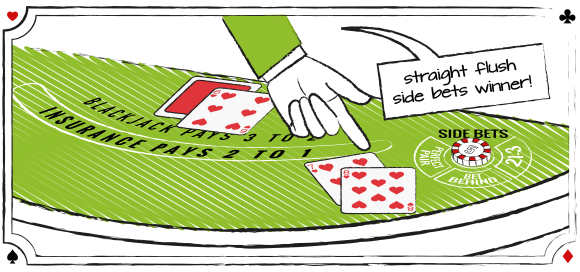
21+3
The 21+3 blackjack side bet pays off based on the player’s first two cards and the dealer’s upcard. If the three cards form a flush, straight, threeof- a-kind, or straight flush, the player wins. In the original version of the 21+3 side bet, the payout for each of the winning hands was 9 to 1, resulting in a house edge of 3.24%. Nowadays, new pay tables have been introduced that have higher house edges and greater volatility. Eliot Jacobson developed and tested a rather complex card counting system for this game that targets flushes.

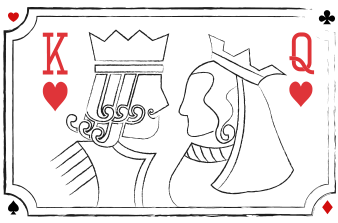
ROYAL MATCH
The Royal Match side bet is offered at single-deck and multi-deck tables. If you make this bet in a multi-deck game, and your first two dealt cards are suited (known as an Easy Match) the payoff is 5 to 2, with a Royal Match - a suited King and Queen - paying 25 to 1. In addition, you receive a 5 to 1 payoff for a suited blackjack. These are player-friendly payouts that results in a house edge of 3.7 percent. In the single-deck version, the payoffs are 3 to 1 for an Easy Match and 10 to 1 for a Royal Match (house edge 3.8%). There is a counting system for Royal Match in Beyond Counting (James Grosjean) and The Big Book of Blackjack (Arnold Snyder).

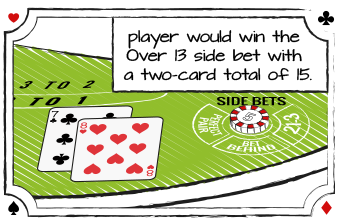
OVER/UNDER 13
A player can wager on whether the sum of his first two cards will be over, or under, 13. A total of 13 always loses and the ace counts as 1. The house edge for the Over 13 wager is 6.5 percent, and for the Under 13, it’s 10 percent. (Yikes!) The side bet is usually offered on six- and eight- deck games. Several pros (e.g., Arnold Snyder and Stanford Wong) have published a counting system for this side bet. You can get the details and performance of these card counting systems from Eliot Jacobson.

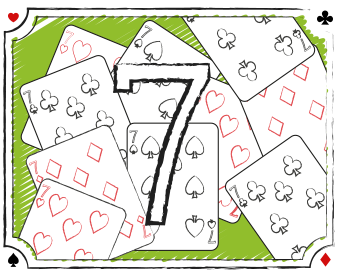
SUPER SEVENS
The player hopes for lots of 7s - the more the merrier. If his first card is a 7, it pays 3 to 1. If his first two cards are 7s, the payoff depends on whether they are suited (100 to 1) or unsuited (50 to 1). Draw a third 7 and now it really gets interesting. If his first three cards are unsuited 7s, the payoff is 500 to 1, and if suited, he receives the top payoff of 5,000 to 1. In some casinos, when the dealer has a blackjack and a player has two 7s, the casino won’t deal a third card to the player and the house edge on this side bet is 12.6 percent. However, some casinos will give the player a third card in this situation and the house edge drops to 11.4 percent. The good news is there is a card counting system that can beat this side bet. (Details in The Big Book of Blackjack.) The bad news is that the maximum amount that you are allowed to wager on this side bet is $1, so your gain is 25 cents per hour (or less).

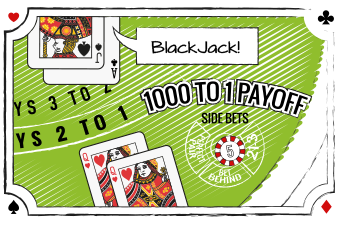
LUCKY LADIES
At the Lucky Ladies side bet players are betting that their first two cards total 20, ideally with two queens. The top payoff is 1,000 to 1 if you get two queens of hearts and the dealer has a blackjack. If you get “only” two queens of hearts, it pays 200 to 1; a matched 20 (same rank and suit) pays 25 to 1; a suited 20 pays 10 to 1; and any unsuited 20 pays 4 to 1. The house edge is 17 percent; however, you can use the Hi-Lo count and get the edge on this side bet when the true count is 6.5 or higher (details in the report by KC Brooks in www.bjinsider.com, issue #147).

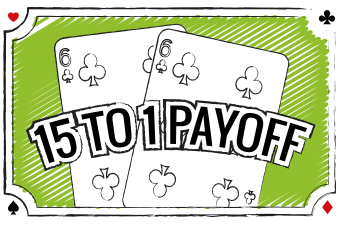
PAIR SQUARE
A player wins this side bet if his first two cards are the same rank (like a pair of 6s). An unmatched pair (like 6 of clubs and 6 of spades) pays 10 to 1. A matched pair (like a pair of sixes of clubs) pays 15 to 1. The house edge is 10.6 percent; however, depending on the pay table, there is a card counting system that will give you the edge. (Details consult www.apheat.com)

KEEPING ABREAST OF SIDE BETS
Every year, I dispatch gambling expert John Grochowski to the Global Gaming Expo in Las Vegas to check out the latest blackjack side bets being touted by inventors and casinos, and he writes a report about them in my Blackjack Insider newsletter. If you search for G2E in our archived newsletter, you’ll find a lot of information on new blackjack side bets. Likewise, Eliot Jacobson often analyzes new side bets and posts on his site (www.apheat.net) whether they can be beaten; similarly.

KEY TAKEAWAYS
- The appeal of blackjack side bets is the relatively large amount of money you can win for a small wager
- Side bets have high house edges and should be avoided
- If you want to wager on a side bet, do research to determine if a counting system exists, and learn the system.

TEST YOURSELF
Try answering the following questions based on the information in Chapter 11.
- Why do casinos offer side bets on their blackjack tables?
- What is the appeal of side bets?
- What determines the payout of a side bet?
- Most side bets have a low house edge. True or False?
- There aren’t card counting systems for side bets. True or False?
- Where can you keep abreast of new blackjack side bets?
Answers
- To increase the margins in blackjack.
- All side bets have more than an even money payout; many pay considerably more. Most side bets cost a player only a dollar wager.
- The payouts, which can vary.
- Dr. Edward O. Thorp.
- False. All side bets have higher house edges than the game of blackjack.
- False. There are card counting systems that have been developed and published for several side bets.
- Check the web sites www.apheat.net, and John Grochowski’s annual report on G2E that appears in the October issue of Blackjack Insider e-newsletter

